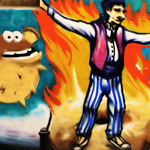 Drawing cartoons isn’t difficult. In fact, the technique is somewhat secondary to the plot. If you don’t have a good plot, even the best drawing technique isn’t going to be of much help.
Drawing cartoons isn’t difficult. In fact, the technique is somewhat secondary to the plot. If you don’t have a good plot, even the best drawing technique isn’t going to be of much help.
On the other hand, a good plot will keep people interested, even if you aren’t so skilled at drawing cartoons. Of course, there’s a minimum skill that you have to have.
First of all, you have to imagine the scene you want. Are the characters running, walking, eating or fighting? Are they sitting on objects?
Once you have this, you can establish a perspective. Drawing cartoons involves separating things in a first and a second plane, at least. The first plane will have the main characters. The second one will have the scenery against which the action is taking place.
The level of each plane will depend on your personal taste, technique and requirements of the drawing. In general, the first plane will be more detailed and the second one will be simpler. However, in some projects, it’ll be the opposite.
In any case, drawing cartoons starts with the general bodies and outline of the characters of the first plane. This can be as simple as drawing a circle for the head and five lines for the body, the arms, and the legs. Try to keep scale consistent throughout your drawings. Women are usually 5 or 6 heads tall, while men are 7 or 8. If you want to create taller or shorter characters for humor or other purpose, be sure to take note of the scale you’re using for each of those characters.
The next step when drawing cartoons is creating the face. Because cartoons don’t need to keep human dimensions, you can experiment where you place the ears, nose, eyes and mouth. Again, in order to be consistent, you need to keep the same face dimensions for a character in every drawing. You might want to take notes or draw a standard face for each character which you can refer to whenever you need it.
Next come the body and the arms and legs. Again, when you’re drawing cartoons, you don’t need to respect human dimensions. A character can be too fat or thin or his arms or legs might be too long or short. Remember to keep abnormally dimensions noted for each character, so you can repeat them consistently.
Finally, the last part of drawing cartoons includes drawing details, such as clothes, shoes, any accessories, and of course, scenery.
If you find the process difficult at first, don’t desperate. Although some people are born with better ability for drawing cartoons, you can always improve by practice, practice, practice.